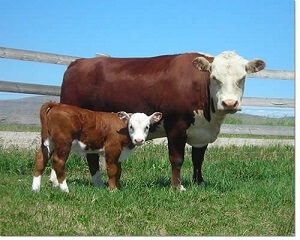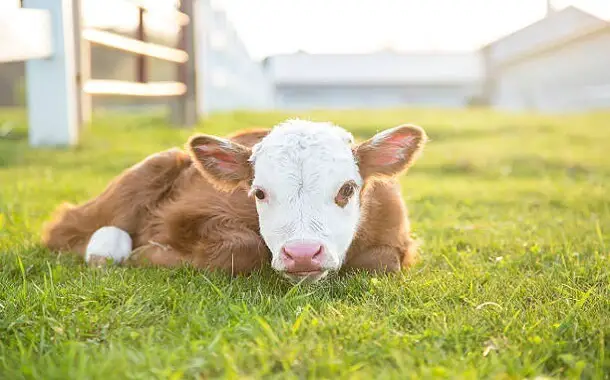How Much Do Hereford Calves Cost?
Last Updated on January 17, 2024
Written by CPA Alec Pow | Content Reviewed by ![]() CFA Alexander Popinker
CFA Alexander Popinker
With their signature red bodies and white faces, Hereford cattle reign as one of the most iconic beef breeds. For ranchers and farmers looking to build quality cow-calf operations, Hereford calves present a robust genetic option. But what exactly does it cost to invest in these young bovine animals?
This comprehensive guide breaks down current Hereford calf pricing while equipping you to evaluate value and returns on cattle farm investments.
We’ll overview the renowned Hereford breed and its advantages before delving into calf costs from birth to weaning. You’ll discover market price ranges based on calf age, weight brackets, gender, and the lineage attributes prized by both commercial and seedstock buyers.
Whether looking to sell or purchase, you’ll gain insider analytics to project budgeting, optimize profits, and drive sustainable farming success. Let’s jump in!
How Much Do Hereford Calves Cost?
Hereford cattle prices can vary widely, with costs between $300 for newborn calves, and up to $5,000, for mature brood cows. On average, Hereford calf prices range from $500 to $1,800, depending on age and purpose. Regional factors may influence prices, with some areas commanding premiums up to 20% above average rates.
Newborn Hereford Calves (1-4 Weeks Old)
Pricing Range: $300 – $700 per head
More of a specialty niche market aimed at breeding operators seeking herd additions rather than commercial finishers due to increased early husbandry demands. But smaller homestead farms gain price advantage at this stage.
Pre-Weaned Hereford Steer Calves (4 Weeks to 6-9 Months)
Pricing Range: $500 – $900 per head
Weigh gains start accelerating while feeding inputs and oversight are still needed, sparking the interest of feedlots willing to invest further post-weaning when the cost of rapid daily gain production drops even more. Markets remain highly localized at this in-between stage.
Weaned Hereford Steer Calves (6-9 Months, 450-700 lbs.)
Pricing Range: $900 – $1,800 per head
Healthy steers sold shortly after separation from dams hit primes both for fewer husbandry demands and well-timed finishing timelines. Most uniform calf groups are sold in 50-100 head lots. Weight benchmarks and weaning dates attract feedlots seeking simplified mass purchases with projected harvest scheduling.
Bred Hereford Heifers (12-24 Months, 800-1,100 lbs.)
Pricing Range: $1,500 – $5,000 per head
Exceptional future brood cow prospects touting genetics suitable for propagating superior maternal milestones like fertility into later ages, sound udders and calving ease. Embryo transfers from prized donors with multiple generations of quantified excellence magnification even higher value bloodlines.
Seedstock operators market bred heifers nationally, transporting pregnant cattle to new homes. Higher transportation costs and the guarantee of an inevitable calf influence premiums.
Some breeders also implement embryo transfer, producing multiple calves from a single superior dam during condensed periods – maximizing fertility windows while amplifying the very best maternal genetics.
Such elite heifer pricing stays exclusive to narrow buyer groups like competitive seedstock producers seeking quantitative hereditary advantages. Average commercial cattle finishing operations source more affordable replacements locally instead.
Mature Hereford Brood Cows (2+ Years)
Pricing Range: $1,800 – $5,000 per head
For established breeding herd owners seeking highly pedigreed introductions backed by hard data production metrics, investing in time-proven mature brood cows adds bankable value. Quantifying the performance of earlier offspring highlights reliably fertile dams and those likelier to yield calves with superior finishing abilities or other bankable traits like marbling.
When evaluating pricing, remember location also plays a role. In leading U.S. cattle regions like Nebraska where supply concentration attracts processors and traders, local calf prices trend 15-20% above coasts.
Ranchr.ag reports that the cost of Hereford calves can range from $900 to $3,000, depending on various factors such as age, weight, location, economic conditions, and market value.
Herdx.com reports that the price for beef cows, such as Hereford, typically ranges from $2,500 to $3,000, depending on weight, age, overall health, and breed.
Hereford Cattle Breed Overview
With roots tracing back to 1840s England, Hereford cattle first reached America by 1817. Their smooth red coats and distinctive white faces caught collectors’ eyes early on.
Beyond aesthetic appeal, Herefords rapidly built a reputation as hardy-working cattle with efficient feed-to-gain conversion. Their calm dispositions and nurturing maternal instincts also established them as ideal for crossbreeding beef enhancement programs.
Today, Hereford cattle populate pastures worldwide thanks to favorable traits like fertility, longevity, grazing ability, meat tenderness, and high carcass yield, particularly excelling in grass-fed beef schemes.
Both large cattle ranching operations and small-scale family farms continue investing in Hereford calves as the breed strongly delivers on multiple fronts: productivity, meat quality, hybrid vigor, and market demand.
Factors Influencing The Cost of Hereford Calves
Like any specialized sector, a multitude of variables shape calf pricing:
Age Bracket – Newborn calves cost exponentially less than weaned juveniles ready for independence. But baby animals require round-the-clock nurturing and higher health risk.
Weight Range – Heavier calves fetch higher price tags at sale barns. Rapid weight gain signifies vitality and efficiency for buyers.
Gender – Due to higher reproductive value, heifer (female) calves sell for 5-10% premiums over steers across age groups. Some producers even advertise polled genetics.
Pedigree Papers – Verified ancestral breeding records affirm genetic merit. Premium bloodline tracing promotes 20-40% sale markup versus unverified cattle.
Regional Demand Trends – In leading U.S. cattle production zones like Nebraska, regional branding and specialty programs incentivize buyers to pay above commodity prices for breed promotion.
Of course, inputs like livestock feed, medical care, and general farm overhead apply across the board too.
Selecting Hereford Calves – Traits to Look For
For ranchers buying Hereford calves as future herd additions, focus on these indicators of long-term potential beyond purchase price alone:
Vaccination Records + Health History – Robust immunity and preventative care from early on optimize outcomes. Quarantining new arrivals allows adjustment.
Body Condition Scoring – Alertness, mobility, hair coat, frame size, and weight offer clues to vitality. Under/overweight animals prompt concern.
Ancestral Breeding Documentation – Reputable Hereford breeders track statistics across generations. Birth weights, weaning weights, carcass data, and maternal records guide genetic selection.
Disposition + Temperament – Nervous, erratic behavior implies stress. Calmness and curiosity in calves mean easier acclimation to handling for care/feeding. Less accidents!
You might also like our articles about the cost of a Miniature Highland Cow, a bull, or a Black Angus Cow.
While higher first-time costs challenge budgets, healthy bloodlines save exponentially long run.
Long-Term Cattle Raising Costs
 Past the initial calf purchase investment, factor these recurring expenses into your farm’s financial plan:
Past the initial calf purchase investment, factor these recurring expenses into your farm’s financial plan:
Specialized Nutrition + Supplements – Vet-approved feeds with nutrients for growth/weight gain have greater upfront costs than generic hay/grains.
Medical Care + Vaccines – Prevention costs far less than treatment! Establish relationships with large animal vets nearby.
Facilities + Infrastructure – Ongoing maintenance/utilities for barns, fencing, and water systems. Seasonal costs like bedding/insect control.
Labor – If hiring ranch hands for calf monitoring, vaccinations, etc. wages add up.
Automation via monitoring tech helps.
While raising costs tally over the years, efficient operations and strategic breeding/selling optimize profit potential.
Maximizing Your Investment Returns with Herefords
With cattle cycling spanning years not months, Hereford farmers must take long-range views, leveraging options like:
Female Retention – Raising robust generations continuously multiplies assets. Split-sex breeding lets you market finished steers annually while expanding mama herd numbers over time.
Data-Driven Genetic Selection – Keep the best bloodlines by analyzing ancestral and offspring performance metrics. Customize breeding from quantified strengths.
Regional Linkages – Liaising with beef promoters and breed associations boosts market reach and pricing through exclusive buyer network opportunities.
Farm Diversification – If hectares allow, dedicating designated pasture to calves keeps programs separate. Alternate grain crops help land rejuvenation too.
Think beyond year-to-year income generation to enact decade-spanning value creation through vertically integrated cattle farming!
Frequently Asked Questions
Let’s explore answers to some of the most common farmer questions about investing in Hereford cattle:
What are the average market prices for Hereford calves currently?
On average, expect to invest $700-$1,200 on Hereford calves depending on age, weight class, and papers verifying ancestry. Average pricing applies to commercial cattle aimed at finishing programs.
Registered seedstock bloodlines selling as breeding prospects for ranches command 2x-5x those averages in premium pricing.
How do factors like age, weight, and pedigree affect the cost of Hereford calves?
Heavier calves aged 6+ months sold at weaning bring 10-20% premiums over lighter-weight neonatal calves due to reduced care demands.
However, elite ancestry and genetics can drive registered breeding calf prices exponentially higher despite youth and smaller frames.
Are there seasonal pricing variations in the Hereford calves market?
Yes, predictably so! Spring calves sold shortly after calving season between March and June usually fetch 10-25% lower prices due to market saturations.
By comparison, ranchers selling fall/winter calves benefit from lower supply dynamics, with buyers competing more to secure additions ahead of cold months.



Leave a Reply
Want to join the discussion?Feel free to contribute!